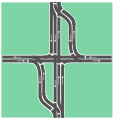Height freedom
From grade separation , even level of freedom , crossing freedom or plan freedom , an intersection is in Germany in the Transportation Infrastructures spoken when two or more roads do not intersect in the same plane. A route with at least one bridge or tunnel is led over or under the other.
A height-free crossing can be implemented with or without a junction . Typical examples of the design without a junction are bridges over dirt roads over motorways.
The best-known examples of height-free crossings with junctions are motorway junctions and motorway triangles . The two streets are connected by ramps so that one can switch from one street to the other .
At the railroad there are height-free crossings and junctions with overpasses , especially in the area of high-speed lines and large railway junctions . Crossings of railways and roads with overpasses and underpasses are also referred to as having no elevation. The § 2 and § 3 Eisenbahnkreuzungsgesetz (law on crossings of railways) provide for the expansion of the proportion of level crossings in Germany and stipulate that new crossings of railways and roads are to be created as overpasses.
Level equality


In contrast, we speak of equality height (also plan equal to or at the same level ) of an intersection when two roads intersect at the same level and thus make a right of way (possibly with structural measures such as restriction of level crossings) are necessary. The simplest example is an ordinary street crossing, but every level crossing also represents an intersection at the same level. Two rail lines can also cross each other at the same level. A ferry over an artificial waterway is also a level crossing. A particularly unusual level crossing can be found in Gibraltar, where a busy road runs across the runway of the local airport. A restricted set of traffic lights blocks the road in the event of aircraft movements.
A transition is also considered to be at the same height if there are ramps immediately afterwards, e.g. B. when people cross the railroad tracks at the same level as the platform, but then immediately lead ramps or steps to the height of the platform.
Partial height freedom
One speaks of a partial height- free intersection if it is still necessary to turn left or left on at least one of the intersecting streets. A road that does not turn left or turn left is referred to as free of intersections. There are two types of partial height-free nodes:
- None of the streets are free of intersections.
- One of the streets is free of intersections.
A typical example with an intersection-free road is a motorway junction . This design is more cost-effective because fewer connection ramps are required. The completeness of the height clearance is indicated by the ratio of left-turns left to traffic directions. A junction with six ramps is therefore ¾-height-free.
Height freedom
If both streets are free of intersections, it is a height-free intersection. The best-known example is a motorway junction.
Partial height equality
Partially level or partially level traffic hubs are defined in the guidelines for the construction of roads (RAS) with streets intersecting at no level and connected to each other on the same level.
Plan-free
shamrockDutch ramps without partial plan
Advantages and disadvantages
Advantages of height-free intersections
- High capacity
- High speeds possible
- Great security
- Shorter waiting times for subordinate road users, sometimes no need to stop
Disadvantages of height-free crossings
- High construction and maintenance costs
- Big need of space
Individual evidence
- ^ Institute for Roads and Railways at KIT: Design and Construction of Roads - Part: Road Design. (PDF; 8.44 MB) Retrieved September 7, 2013.



